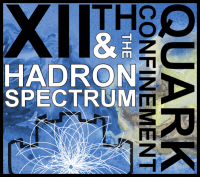Speaker
Description
The precise SIDDHARTA value of the energy shift and width of kaonic hydrogen has awaken a renewed interest for the meson-baryon interaction in the $S=-1$ sector. Our study has been carried out based on a chiral SU(3) Lagrangian up to next-to-leading order (NLO) and implementing unitarization in coupled channels, since the presence of $\Lambda(1405)$ resonance makes not applicable a perturbative treatment of the Chiral Lagrangian in the energy region we are dealing with. The parameters of the model have been fitted to a large set of experimental $K^- p$ scattering data in different two-body channels, to threshold branching ratios, and to the above cited data from SIDDHARTA . In contrast to other groups we take into consideration the $K \Xi$ channels which are very important to obtain more reliable values of the fitting parameters, in particular the NLO coefficients. We have shown in [1,2] that the $K^- p \to K \Xi$ reactions are very sensitive to the NLO terms of the Lagrangian and also to the Born direct and cross diagrams. This fact is due to the null direct contribution of the Weimberg-Tomozawa (WT) term to the scattering amplitude of these particular reactions.
On the other hand, the $K^- p \to \eta \Lambda$ reaction has associated a pure isospin $0$ ($I=0$) amplitude, and therefore, it constrains the relevance of the role played for each isospin component. In general, a good description in terms of the isospin decomposition is crucial to reproduce properly processes in which a single isospin component is filtered, such as for instance the $K_L^- p \to K^+ \Xi^0$ reaction which could be measured at the proposed secondary $K^0_L$ beam at Jlab and which is a pure $I=1$ process. Another interesting measurement is the $\Lambda_b \to J/\psi K \Xi$ decay which filters I=0, as was studied in [3].
[1] A. Feijoo, V. K. Magas and A. Ramos, Phys. Rev. C 92 015206 (2015).
[2] A. Ramos, A. Feijoo and V. K. Magas, arXiv:1605.03767 [nucl-th].
[3] A. Feijoo, V. K. Magas, A. Ramos and E. Oset, Phys. Rev. D 92, 076015 (2015).




